The world is currently experiencing “the highest number of violent conflicts since” World War II, against the backdrop of the triple planetary crisis of climate change, pollution, and biodiversity loss. While millions live in the reality of this devastation, UN member states and other global actors are simultaneously trying to build a framework to secure a peaceful and sustainable future for children and future generations. Yet there is a sharp disconnect between the hope embodied by documents like the UN “Pact for the Future” and the despair that many may be experiencing as a peaceful global order seems to be under ever greater threat. To address this disconnect, it is essential that states take meaningful action to end ongoing conflicts and counter their impacts on children and future generations.
Conflict and children
Children are often disproportionately affected by conflict or even deliberate targets. This is all too true in many ongoing conflicts.
In Ukraine, Russia has used child abduction as a deliberate strategy of war and domination, with around 20,000 children reportedly taken from Ukraine to Russia, leading the International Criminal Court to issue an arrest warrant for Russian President Vladimir Putin and Children’s Commissioner Maria Lvova-Belova.
By September 2024, it was estimated that Israel had killed more than 11,000 children in Gaza, making it the deadliest conflict for children in recent years. The health and educational impacts—even for surviving children in Gaza—are such that one UN official has said the region faces a “lost generation” of children. UNICEF has described Gaza as a “graveyard for thousands of children” and “the most dangerous place in the world to be a child.”
Unfortunately, there’s competition for that particular superlative. Sudan might be another candidate, with a greater number of children displaced by conflict than anywhere else in the world—4.6 million since April 2023 alone—and rising reports of sexual violence against children being used as a tool of the conflict.
Conflict and environmental devastation
Direct physical impacts on children aren’t the only way that these conflicts could damage their health and well-being for years, and even generations, to come. Conflict has significant yet often overlooked environmental impacts.
Russia is accused of purposefully targeting environmental infrastructure and “rivers, forests, and fields” in Ukraine. There is evidence that Israel has leveled “orchards, greenhouses, and farmland,” as well as destroying water infrastructure and causing significant air pollution. In Sudan, the conflict is contributing to environmental degradation through the destruction of agricultural and water resources and increasing vulnerability to climate impacts.
While knowing exactly how much conflict contributes to carbon emissions is tricky, recent studies have suggested that “[t]he projected emissions from the first 60 days of the Israel-Gaza war were greater than the annual emissions of 20 individual countries and territories,” while the first year of Russia’s war in Ukraine contributed 120 million metric tons of carbon to the atmosphere. Globally, military activity might be the source of 5% or more of all carbon emissions.
All of this means that even after these conflicts are over, children and future generations will be left trying to rebuild their lives in a landscape that is degraded and a climate that is warmer and more volatile.
The worst possible timing
These are not impacts that the world can afford. Just as conflicts are aggravating the triple planetary crisis and eroding the possibilities for shared solutions, the world is reaching the threshold of a number of irreparable environmental harms. Without urgent emissions reductions, Arctic and Antarctic ice sheets, ocean current systems, and the Amazon rainforest are all at unbearable levels of risk. Environmental impacts are straining the planet’s ability to support human life, as well as endangering an enormous number of the species with which humans share the Earth and upon whom we rely for our well-being.
Conflicts do not just add to the environmental damage being inflicted—they also divert resources away from efforts to address existential threats. They amplify global divisions, making it even less likely that the international community can come together to find the genuine and equitable solutions to these shared problems that we so desperately need.
A paper framework for the future
Even as conflict engulfs the globe, harming children and future generations, global actors are creating new laws and policies aimed at protecting them. UN member states just adopted the “Pact for the Future,” which includes commitments to environmental preservation and to addressing peace and security concerns through a youth, peace, and security lens. It also includes as an annex a “Declaration on Future Generations,” which emphasizes both peace and the environment.
There is an important new global legal development in this area: the Maastricht Principles on the Human Rights of Future Generations, a guidance document developed by leading experts to clarify states’ legal obligations to those who will inhabit the planet after us. The principles articulate a duty to “protect and sustain the Earth’s natural and cultural heritage” and an obligation to prevent foreseeable harm due to state conduct. The Maastricht Principles are soft law, but some of what they articulate is increasingly being confirmed by domestic courts in youth climate cases. From Colombia to Germany to Canada, courts are confirming the obligations of states to protect the human rights of children and future generations by putting an end to environmental destruction.
These legal victories ring hollow, however, in the face of ongoing war and environmental devastation. From fundamental human rights and environmental treaties to these new laws and policy commitments, states and those committed to promoting human rights have a significant body of legal and rhetorical tools at our disposal to secure a better future for our children and for theirs. But all of the written commitments in the world mean nothing when children are being bombed today, and their homes are being destroyed for tomorrow. These tools are only useful if the global community turns away from destruction and towards constructing the world that future generations deserve.

